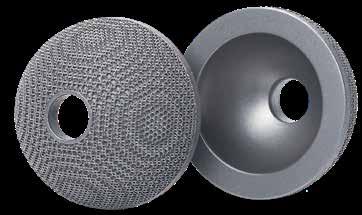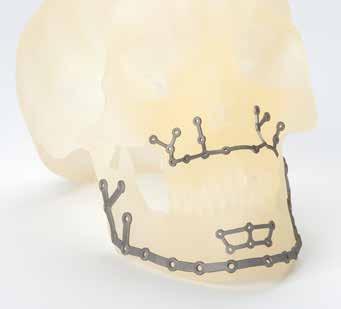
7 minute read
3D-printed medical implants
from AMT AUG/SEPT 2020
by AMTIL
Made to measure: 3D-printed medical implants for joint and musculoskeletal patients Media outlets frequently run stories detailing how uniquely designed 3D-printed parts implanted into patients are offering a welcome, ‘never-before-available’ solution to medical problems.
These stories have featured items such as a 3D-printed prosthetic jaw designed by the patient’s own doctor; spinal parts to support fractured or damaged vertebrae; a patient-specific sternum, and so on. These are just some of the phenomenal achievements 3D printing technology can bring to suffering patients. Becoming increasingly aware of solutions they can offer their patients, doctors are embracing the technology, applying their own knowledge of anatomy, using the latest imaging technology, and working with CAD designers to construct unique parts for their patient. What we are really talking about is a world of ‘customised body parts’ – customised because all human beings are unique and no one size fits all! More common implants occur for hips and knees, but here, most replacement parts used in operations come in a standard size and form. Injuries to knee and hip joints generally arise as a result of musculoskeletal trauma from accidents, sports injuries, improper training practices or when a person is not sufficiently warmed up or stretched in readiness to undertake their exercise regime or compete in an event. These can be acute injuries that require immediate treatment. Chronic injuries arise from overuse of one part of a particular joint or simply due to the aging process. Hip replacement is common practice with the Federal Government, through the Therapeutic Goods Administration (TGA), monitoring implants since 1999 – specifically of metal-on-metal (MoM) parts such as hip replacements. Interestingly, problems appear to arise in complete hip replacements, where the size of one part does not suit the patient, the ‘standard’ part either being too large or too small. Surgical procedures associated with hip implants have been revised, resulting in better outcomes, but the situation negates the emerging opportunities of making patient-specific implants using 3D printing technology. Another advantage of 3D printing that will overcome secondary issues cited by the TGA, is by printing in titanium, specifically Tu6Al4V, a safe, lightweight material. This is replacing products made using chromium and cobalt, which are known to produce undesired side effects due to metal ions entering the body’s blood stream. Advances in titanium hip replacement parts are numerous. Recently, SLM Solutions, a manufacturer of 3D metal printers headquartered in Lübeck, Germany, entered a strategic partnership with Canwell Medical, a leading medical device manufacturer based in China that supplies 30 countries across Asia, the Americas and Europe. SLM
An orthopaedic knee implant.

Solutions has supported the installation of metal 3D printing laser systems by providing technical training along with assistance on research and development. Jerry Ma, General Manager of SLM Solutions Asia Pacific, indicated: “Laser melting technology and medical is an important application field. Our global experience accumulation and innovation will help us develop China’s medical field.” SLM’s unique technology applies complex geometries that guide multiple lasers selectively melting deposition powder layer by layer, resulting in densities as high as 99.9%, highly suitable and safe for orthopaedic hip implants. A recent example produced on an SLM 280 twin laser system are acetabular cups. These items are usually built in a ‘standard’ size but offer distinct advantages. The technology allows the structuring of a porous or lattice structured exterior surface that directly facilitates ‘osseointegration’, the connection between living bone and the surface of a load-bearing artificial implant – a distinct achievement for long-term patient outcomes. According to a study by public health researchers at Monash University, hip replacements are predicted to rise from 25,945 in 2013 to 79,790 by 2030. This has become a ready-made market for an innovative Australian manufacturer. In addition, hip replacement parts are small and easy to ship, providing a real possibility of tapping into an overseas market such as the USA, where more than 300,000 hip replacement surgeries occur annually. Knee replacement, or knee arthroplasty, is a surgical procedure replacing those parts in the knee joint that bear weight and cause pain in patients. Knees are a complex ‘hinge’ joint that bends and straightens with movement. However, the complexity lies in the way the bone surfaces glide and roll each time a knee bends. Knee issues commonly arise from rheumatoid or osteoarthritis, and can be exacerbated by obesity; irrespective of the issue, a great deal of pain is often experienced. While a range of medical options are available to ‘fix’ the problem, knee replacement is quite a common surgical solution. Surgery using standard knee replacement implants can result in a ‘nearly right’ fit. Surgeons are provided with a box of assorted sizes, male or femalespecific, from which they can select. Guided by both image scans and a view of the damage, a suitable selection is often possible. However, an off-the-shelf knee implant may have an overhang or underhang if slightly too large or small, leaving patient outcomes less comfortable than desirable.
The SLM 280 3D printing system from SLM Solutions.

In a complete knee replacement operation, three parts are usually replaced: a femoral component that wraps around the femur, a tibia component and a patella component. A CoCr28Mo6 femoral knee implant has been developed using selective laser melting on an SLM 280 twin laser system. The company’s flagship system, the mid-sized SLM 280 twin selective laser melting system is equipped with a twin laser configuration of 2 x 400W or 2 x 700W, and a bidirectional loader to increase build rates in the 280mm-by-280mm build chamber. The complex software geometries afford integrating a functional lattice structure to assist with implant retention. The item can be produced in multiples as standard replacements but the flexibility in the geometry and build capability offers a cost-effective advantage of producing a patient specific component. Aside from productivity and cost advantages, a further advantage exists in using an SLM 280 twin laser system as the item can be used for a ‘unicondylar’ knee replacement, a partial replacement where damage is confined to only one section. The number of Australians undergoing knee surgery for full or partial replacement has risen by some 38% since 2005-6. Records indicate in the period from 2016-17, there were 53,148 knee replacements carried out in Australia on persons over the age of 18. To meet this rapidly expanding market, support, training and advice are available for manufacturers of medical equipment from SLM Solutions. Opportunities for series production of acetabular cups and intervertebral fusion cages are just some examples of what can be achieved. SLM Solutions undertakes research and exploration projects to improve and enhance their machine offerings, and in developing the all-important process parameters to support users. For example, updates continue on 60-micron process parameters for titanium alloy to print acetabular cups. With knee replacement parts, development of 60-micron process parameters in cobaltchromium alloy continues. Another area into which SLM Solutions’ laser systems are moving is in the development of craniomaxillofacial (CMF) implants. These items are patient-specific, designed and produced for an individual who needs repair or restructure following trauma or illness resulting at times in psychosocial consequences. A number of these implants have been designed and constructed for individual patients. Computerised tomography (CT)-scanned images allow accurate development of computer programs utilising complex geometries. Using lightweight titanium and built in an

SLM 125 system, SLM Solutions has managed to develop implants that fit and support functionality, demonstrating that it is possible to produce reliable patient-matched customised items economically and effectively. SLM Solutions understands the importance of quality assurance and process documentation to qualify the production of biomedical components and is willing to share knowledge and best practice procedures to ensure success in using an SLM laser system. Queensland University recently posted a report regarding the need for standards and regulations to be instituted to meet medical and surgical regulations. Custom-made devices are exempt from stringent testing and documentation, but the situation requires some form of monitoring. A recent example of producing a medical device occurred where SLM, working closely with Forecast3D, a European service bureau, produced a surgical instrument overnight to be used for an orthopaedic shoulder replacement surgery. Using minimal material – 17-4PH stainless steel – and no wastage as waste metal powder is harvested and reused, and with a build of 30-micron layer thickness, the complex construction provided an ideal answer. This case provides an example of shifting additive manufacturing strategies in today’s world of fast, on-demand, customised products. While the introduction of regulations is at the discussion stage, it will be important that flexibility is not hindered and innovation encouraged, perhaps within a loose set of parameters. Nonetheless, right now in 2020, after a pandemic and its economic fallout, opportunities exist to enter or expand this exciting aspect of the medical market both locally and internationally, using selective laser melting systems. www.raymax.com.au











